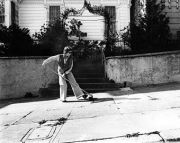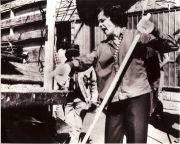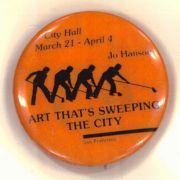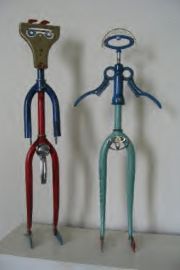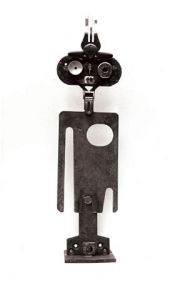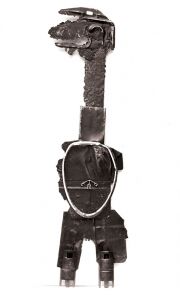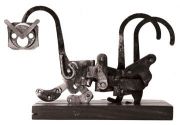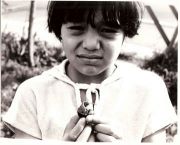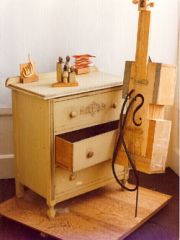Jo Hanson
Artist Statement / Bio
OBITUARY
JO HANSON: Pioneering Environmental Artist Dies in San Francisco
By Susan Leibovitz Steinman
Jo Hanson, a pioneering spirit in both environmental and feminist activist art movements, died Tuesday March 13 at her home in San Francisco. The SF Museum of Modern Art, Oakland Museum of California, Fresno Museum, and Corcoran Gallery of Art in Washington, DC are among the institutions that exhibited her innovative work that transformed urban waste into meaningful art.
Hanson came to prominence early in the 1970's, soon after she moved into a deteriorated but stately Victorian on Buchanan Street. Once she had resuscitated the house into a landmark, she tackled its windy litter-strewn sidewalk. Her personal act of sweeping one sidewalk grew into a celebrated public art practice and citywide anti-litter campaign. Her compiled volumes of urban detritus are recognized as an artistic political tour de force that raised community awareness as it chronicled rapidly changing demographics.
Not content to be a cloistered artist, Hanson organized city-wide street sweepings, children's anti-litter art campaigns for City Hall, and led a famous bus tour of San Francisco street dumping sites all extensions of her conceptual real-life artworks. Hanson's community-inclusive strategies set precedents in public ecoart, created models for younger artists, and gave poor neighborhoods visual access to City Hall.
Her first nationally touring solo exhibition was an inventive mix of sculpture, printmaking, photography and sound, 'The Crab Orchard Cemetery,' based on her Southern Illinois ancestral graveyard. One writer lauded the1974 installation as exploring roots before Alex Haley and death before the Kubler-Ross book.
A vocal SF Arts Commissioner for six years in the 1980's, Hanson was known for championing the inclusion of deserving underrepresented women and artists of color in the City's art collections. She was the driving force behind saving Lucien Labaudt's murals at the Beach Chalet. She was instrumental in the Art Commission's restoring the Coit Tower murals and acquiring public art for San Francisco International Airport.
In the late 1980's Hanson convinced NORCAL Sanitary Waste recycling and disposal company to develop an artist-in-residency program, offering a studio and stipend for emerging and well-known artists to create artwork from the waste stream to raise public awareness. Nationally recognized and awarded, the AIR program has become hugely successful benefiting 100+ artists and the San Francisco public. Each year more than 2500 SF school children visit the AIR studio and tour its reclamation sculpture garden.
Hanson initiated and collaborated on myriad ecoart exhibits, articles, books, lectures and programs. She instituted, and was awarded for, ecoart programming at Bioneers--the annual international gathering of ecological innovators in Marin County. She was proud of co founding in 1996 WEAD the Women Environmental Artists Directory, a journal, website and international network connecting and documenting the artwork of more than 200 women ecoartists, that also produces yearly exhibits and outreach events.
Recipient of both a National Endowment for the Arts artist's fellowship (1977) and visual arts project grant (1979), Hanson received the 1997 Distinguished Woman Artist Award from the Fresno Art Museum Council of 100. In 1992 the Northern California Regional Women's Caucus honored her for Lifetime Achievement for Art. In 1997 the National Women's Caucus for Art honored her Outstanding Achievement in Visual Arts. Her work is in many public and private collections.
Hanson held two masters' degrees, one in education from the University of Illinois, and reflecting her career change in the 1960's, another in art from San Francisco State.
Jo Hanson is survived and remembered by friends and family, including her children Leni Reeves of Auberry CA and Zack Schlesinger of Santa Cruz, and her grandchildren Ilya Reeves, Aaron Reeves of San Francisco and Jillian Schlesinger of NYC.
ADDITIONAL INFORMATION:
Birth: August 1, 1918
Death: March 13, 2007
Cause of death: Cancer
Burial: March 17, 2007, in Bolinas, CA.
Born in Carbondale, Illinois, she was a CA resident since 1955, living first in Marin County, and since 1970 in San Francisco in her landmark house called the 'Nightengale' house, 201 Buchanan St.
In the 1990's she had a small second home in Monte Rio, CA, along a creek flowing into the Russian River. Active in Sonoma County environmental issues, she often hosted activist meetings at a long wooden communal table under the redwoods. The flooding river inspired an exhibited body of work called 'Gaia Does the Laundry' (1995-96).
Selection of Solo Exhibits: SFMuseum of Modern Art, Utah Museum of Fine Arts, Corcoran Gallery of Art, Pennsylvania Academy of Fine Arts.
Selection of public collections: Cornell University, Mills College, Fresno Art Museum, SF Arts Commission, SFMOMA, Knoxville (TN) Museum of Art, Oakland Museum of Art.
ESSAYS
My Adventures as an Eco Artist
By Jo Hanson
Historically artists have often sensed when their societies were going off course- the Romantics with their perceptions of the tragic side effects of the Industrial Revolution, the Dadaists with their understanding of the insanity World War I and the threat of Nazism. We should heed, then, the growing number of artists in the past few years who are reminding us of the need to live in balance with the Earth.
Evolving into an eco artist couldn't have been farther from my mind when I went out to clean the 180 feet of my 12-foot wide sidewalk in my windy new neighborhood of San Francisco in 1970. The term 'eco artist' didn't exist then, and the work was not readily accepted as art. Aesthetics and a litter-free sidewalk motivated my cleaning, but a great deal more was blowing in the wind: the anguish of the Vietnam War; anger toward the government and the 'Establishment' (Hippie vocabulary) that were responsible for the war; also Hippie culture, with migrations from all over the U.S., drawn by the mystique of the 'Haight-Ashbury' drug culture; ethnic turmoil. I learned the inseparability of sociology and ecology as I saw how anger and discontent expressed themselves in the gesture of trashing the streets- aided and abetted by the wind!
Soon my cleaning extended to the whole block- one to three times daily. City trucks come on to three times daily to haul it away. City workers and I became buddies and collaborators, which led into unanticipated collaborations, which led into unanticipated collaborations down the line. Neighbors like to stop and talk, usually beginning or ending with "Let the City do it; we pay our taxes!". Observing changes in the discards promoted me to begin documenting the street's contents. Disposable needles had disappeared! It informed me that Hippies had left the area. Primarily from privileged families, Hippies knew how to work the system, while other heroin users had no access to disposable needles. More than 100 binders now reflect the contents and changes of the street since 1970.
Street discards flowed like the ocean, instantly renewed after each removal: very personal notes and letters (some appearing at intervals, like continued stories), parking tickets, photos and negatives, bills, collection letters, canceled checks and bounced checks, grocery lists with creative spellings, religious tracts, ZigZag papers for rolling joints, drug paraphernalia, rock posters, advertising, cigarette packages, food packaging, newspapers, books, political and social protest, anti-war artifacts (the demonstration route was only two blocks away), prison discharge papers, medical records, clothing, and much, much more. One could not find a more striking demonstration of the waste society, consumerism, ecological ingnorance, irresponsible industry and commerce, materials waste through irresponsible design.
Through my various activities I learned two very important realities: (1) Trash/junk has great public appeal, and feature people are eager for good stories. The issues of waste and consumerism could get mass attention via media features. I analyzed the elements of effective feature stories and appreciated mass outreach for the 'messages' of my work. (2) Knowledge alone does not bring change in ecological bad habits. Emotional commitment is needed; the heart must be engaged. I learned this from two boys attacking a newly planted street tree with a plumbing pipe. When I stopped them and began about oxygen and carbon dioxide exchange, the said " Oh, we know that!" They learned it at school. But neither their knowledge nor their own need for oxygen made hem cherish the tree instead of trying to destroy it.
During the late 1970's and early 80's I documented community 'clean-ups'. I collaborated with the street cleaning department in various City Hall presentations and curated a school contest for the mayor's committee on litter management. This attracted 1,700 students and their teachers, who used it as curriculum enhancement. In 1980 I received a grant for an exhibition of the various facets of my work in City Hall (and the San Francisco Museum of Modern Art). The exhibition displayed artifacts from the street, my documentation, community vignettes, and the work and personnel of city street cleaning.
Clearly, this kind of work reflected an on-going revolution in art and artists. I identified first with conceptual art's advocacy of art as experiences or phenomena that could not be bought and sold. But it was feminist art that fulfilled the aims of conceptual art in empowering artists, collaboration among artists and with communities, advancing life and social experiences/issues as appropriate subjects of art. This was my trail in discovering that my work was 'environmental art'. I have never felt related to the land artist of that period who used earth features and nature as their materials.
In 1982, when the International Sculpture Conference met in the San Francisco Bay Area, I organized a Dada-style bus tour of illegal dumping in San Francisco. It provided unusual insights, as well as a good tour of San Francisco.
The totality of my experiences parlayed into my proposing an Artist in Residence program in San Francisco's disposal company: Sanitary Fill Co., a division of Norcal Waste Systems, Inc. This company and Norcal are unique in having grown up with the city from groups of Italian scavenger cooperatives that collected with horse and wagon. They have always salvaged for economic reasons. They also had the vision to see the potential of art and artists as outreach to encourage public cooperation in wast reduction and recycling to achieve their state-mandated reduction in landfill.
The Artist in Residence (AIR) program opened in 1990. It has won several prestigious awards, but primarily it is an ever-increasing resource in public and student education and persuasion. It maximizes art's unique ability to reach out and catch the imagination and the heart of its 'audience'. Interestingly, the artist community also has become more sensitized to ecological concerns. The Open Studios reception that conclude each residency often attract 400-500 mainly young people. In addition to the art, I believe they are drawn to the energy and rawness of this big muscle industry that serves such a positive and sensitive role. The residency is heaven on earth for artists. The quality of their work is very high.
Many artists evolve new dimensions in this 'shock' of unlimited possibilities. Chosen by a well qualified advisory board, artists receive a stipend, access to any and all materials, big rangy studio space with 24-hour access, any equipment or tools that they need, the assurance of good exposure of their work. The company gets one artwork; the rest belongs to the artist. In 1999 the AIR program became the core of a new Environmental Learning Center. About 6,000 school students yearly tour the recycling and disposal facilities and artist studio, along with many other public educational activities.
One could not find a more striking demonstration of the waste society, consumerism, ecological ignorance, irresponsible industry and commerce, materials waste through irresponsible design.
Two years later, in 2001, another kind of residency was added for art students, in a separate and smaller studio. They are not paid, but they receive a $500 budget and access to any material that comes in. The target audience for this part of the program is the 'young 20s' population. The word spreads through the art schools and stimulates attendance at the studio tours and receptions that close each regular residency. This company's commitment to educational outreach provides a powerful model for other companies in any area.
Initially, for many years, I refused to make art objects that could divert attention from issues to objects. But a week of daily 'deliveries' of cut-out hearts and music notes broke my resistance. I began doing collage work. Later I turned to sculpture using unique metals that are crushed by street traffic. This was timely because, beginning in the late 1980's, the non-profit galleries (and others later) began to trickly and then flow of 'eco' exhibitions. In that context, exhibiting art objects promoted discussion of ecological concerns and led to lectures, and workshops, panels and symposia.
'Rising Above Our Garbage', a major three-day interdisciplinary conference in which I participated in 1993, focused on waste management. It assembled at the sponsoring San Francisco Exploratorium, and was organized by Mierle Laderman Ukeles, resident artist in the New York City Sanitation Department since 1975. Cross-disciplinary discussion involved public officials, engineers, artists, arts administrators, waste management personnel and an economic analyst. A diverse and highly qualified audience participated in a review session each day. Specific projects and their problems and solutions were presented. Discussion of projects led by artists, or including artists, noted particularly the integrative influence of the artist and the value of the artist's ability to 'think outside the box'. Cases were cited in which artist participation let to transforming design and planning problems into amenities, with cost savings. Probably un-resolvable questions concerned the ethics of artist participation in disguising closed landfills as parks/ amenities. Does the recycling of landfills into public amenities undermine the public perception of the need to recycle, to resist consumerism and avoid non-recyclables? Closing a landfill is a costly operation, whether as a park or object lesson in waste.
Work in ecology leads to experience of the intelligent energy of nature, the wisdom of natural process.
The first Women Environmental Artists Directory sprang into being in 1996 to fill the eco void in the program of a Regional Conference of the Women's Caucus for Art. One of the three founders excused herself to manage the crunch of other work; and Susan Steinman and I found ourselves with another responsibility too much. We invited nine equally overworked artists to share it with us. The result was magic. Each advisory board member is an accomplished artist in different areas of eco art, providing wide range networks and resources. The Directory is artist-supported. Circulation is national with a small international listing and distribution. The primary intention is to serve artists and artists selections by curators, writers, administrators and whoever else needs artist information. Our website is www.weadartists.org.
In 1999 Steinman, Aviva Rahmani ('Ghost Nets', Maine) and I co-chaired a shockingly large panel of nine eco artists at the annual conference at the College Art Association. Our panel description noted the rapid increase in eco artists; the widening parameters of work; collaborations among artists, but also across disciplines and with communities, in re-invigorated relationships; the inventive strategies; and vocabulary that exceeds conventional aesthetic discourse. We called for an update of the status and practices of eco art.
In all the work that I've described one can almost assume a spiritual dimension. Work in ecology leads to experience of the intelligent energy of nature, the wisdom of natural process. Even working early-on with urban trash, my anguish for the Earth was relieved in realizing the import of my utter failure to stop weeds from growing in the sidewalk cracks. Trying, later, to restore an ecosystem I learned that a lost ecosystem cannot be called back or re-created, but the weeds and the failed ecosystem taught me that Earth energy is persistent and will choose its manifestation, lawfully and with infinite imagination.
Mainstreaming eco art had been a concern of all my work. Increasingly my experiences provide opportunities to promote eco art and artists for the richness of their integrative, innovative thinking and the means that they bring to both education and action.
This article was reprinted from the 2003 issue of Land and Eco Art in the USA

